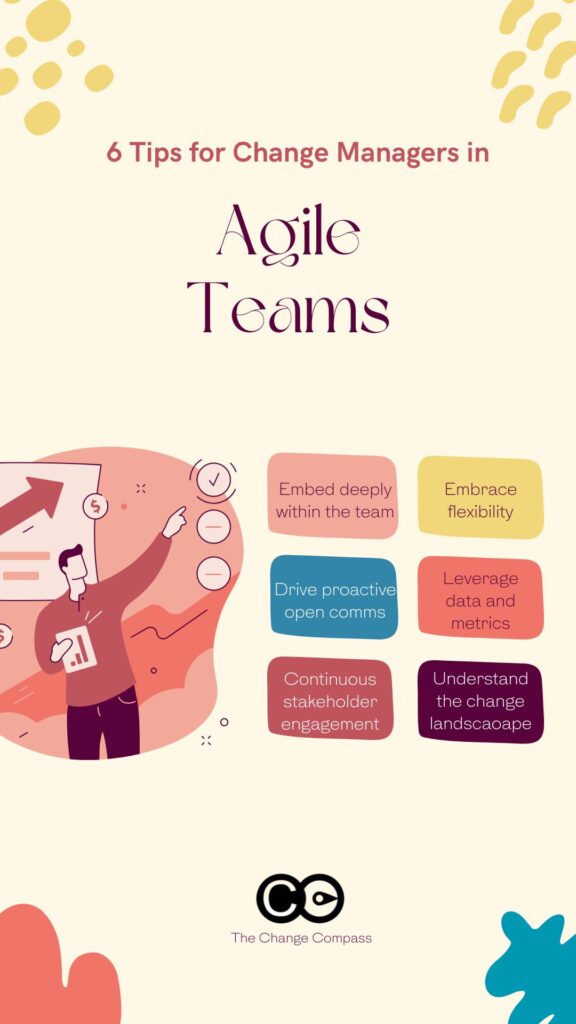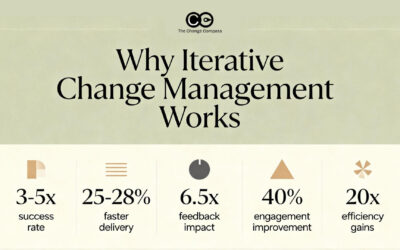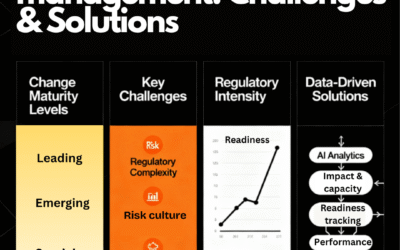The role of change managers has been left out of the various agile methodologies. This is even though most fully acknowledge the importance of change management in the success of initiatives. Does this mean that the agile teams should and can take on the role of change managers? While most of you reading this article may have change practitioners in the organisations, there are plenty of organisations that run agile teams without change managers in the team.
Is it that in agile environments, change management responsibilities are distributed across team members rather than centralised in a single role? After all the agile team is self-organising and has shared accountability?
For organisations that do not have change managers in agile teams, they are still able to deliver valuable and continuous changes. The difference is in how effective the agile team is in delivering a solution where:
- A range of stakeholders are continuously engaged effectively and therefore have high levels of readiness
- Stakeholders’ readiness for the pace and design of agile is taken into account and various education/engagement sessions are designed as required
- They’re able to identify the various behavioural changes required in fully adopting the change
- Stakeholders continuously track and reinforce adoption
- The team is aware of the change landscape of impacted stakeholders and can work with them respectively to design and deliver in a way that maximises adoption in a targeted way
It is quite difficult for a small agile team to have all these skillsets. You can equally place the same argument for Business Analysts. Even if the team does not have this role, they could equally undertake a lot of the tasks that a Business Analyst would typically undertake in an agile project, however, maybe not at the same level of professionalism and rigor.
In a small agile team of cross-functional specialists, by design each member is a specialist in his/her functional domain, whether it is testing, software development, operations, etc. It would be rare for a domain specialist to have such a breadth of skillsets to include a range of change management skills. Of course, this is not impossible, but difficult for a team to possess.
An agile team is by design focused on delivering. By design, the agile team is laser-focused on its iteration work and delivering to the schedule at the right quality. It does not have a lot of capacity to devote itself to working with a wide range of stakeholders as a result. The change manager, on the other hand, is by design focused on the world of the stakeholders as well as what the agile team is delivering and designing a series of steps for the changes to take place or a people and organisational perspective.
Moreover, beyond project change management skills, organisations that have a myriad of self-organising agile teams require greater air-traffic control at a portfolio and enterprise level. Whilst this may be fulfilled from a portfolio management perspective, attention should also be paid to change portfolio management. Within a fast-paced change environment, the capacity stakeholders across the organisation have for the changes, and the overall prioritisation and sequencing for these changes are paramount.
Without this, changes may fall off the radar, superseded by other competing changes delivered by other agile teams. Alternatively, change saturation fatigue may be a result. In fact, there is increasing evidence that this is prevalent across organisations. Stakeholders’ capacity for change is limited and must be managed effectively to ensure the right changes are adopted.
If change management so critical to agile changes let’s delve into the essential role that change managers play within agile teams, breaking down their contributions across the four typical phases of an agile initiative: Define, Build, Test, and Deploy.

Define Phase
During the Define phase, agile teams lay the groundwork for the project by identifying objectives, scope, and initial requirements. For change managers, this phase is critical for assessing the scope and complexity of the change and determining the necessary resources and support structures.
Key Activities for Change Managers in the Define Phase:
1. Assessing Change Size and Complexity: Change managers evaluate the magnitude of the change and its potential impact on various parts of the organization. This assessment helps in tailoring change management strategies to address specific needs.
2. Resource Planning: Identifying the required business and change support resources is essential. This includes assembling a team of change champions, communication specialists, and trainers who will help facilitate the change.
3. Strategic Planning: Developing a comprehensive plan that outlines key activities and tactics to engage stakeholders and drive successful change. This plan acts as a roadmap for the entire change management process.
Build Phase
In the Build phase, agile teams start developing the solution. Change managers intensify their efforts to understand the potential impacts of the change and begin engaging stakeholders.
Key Activities for Change Managers in the Build Phase:
1. Detailed Stakeholder Assessments: Conducting thorough assessments to identify how different stakeholders will be affected by the change. Understanding these impacts is crucial for tailoring communication and training efforts.
2. Initiating Stakeholder Engagement: Early engagement with stakeholders to communicate the vision, goals, and expected outcomes of the change. This engagement helps in building awareness and buy-in from the outset.
3. Scenario Planning: Since the exact nature of the change may not be fully defined, change managers work with various scenarios to anticipate potential challenges and opportunities. This flexibility allows for adaptive communication and engagement strategies.
Test Phase
The Test phase is where agile teams validate the solution through testing and feedback. For change managers, this phase is pivotal for ensuring stakeholders are prepared for the upcoming changes.
Key Activities for Change Managers in the Test Phase:
1. Collaborating on Testing Processes: Working closely with agile teams to determine how stakeholders can be involved in testing. This may include business testers, change champions, or end-users who provide valuable feedback.
2. Designing Communication Content and Learning Interventions: Developing and rolling out communication materials and training programs to prepare stakeholders for the change. These interventions are tailored based on feedback from testing.
3. Engaging Stakeholders Through Various Channels: Utilizing demos, team briefings, and other engagement channels to keep stakeholders informed and involved throughout the testing process.
Deploy Phase
The Deploy phase marks the transition of the solution into the live environment. Change managers play a crucial role in ensuring a smooth transition and full adoption of the change.
Key Activities for Change Managers in the Deploy Phase:
1. Ensuring Readiness: Before deployment, change managers gather evidence that stakeholders are ready for the change. This involves assessing training completion, communication effectiveness, and overall preparedness.
2. Executing Engagement Strategies: During deployment, change managers leverage various engagement channels to support the transition. This includes continued communication, support hotlines, and face-to-face interactions to address any concerns.
3. Monitoring and Feedback: Establishing performance metrics to monitor the adoption and effectiveness of the change. Feedback is collected and analyzed to make necessary adjustments and integrate the change into business-as-usual operations.
Key Differences in Change Management for Agile Teams
While the core principles of change management remain consistent, their application within agile teams introduces unique challenges and opportunities. Here are some key differences:
Proactive Integration in Cross-Functional Teams
Change managers actively contribute to the progress of agile teams by embedding themselves within the cross-functional team structure. This close collaboration ensures that change management activities are aligned with the development process, allowing for more effective and timely interventions.
Flexibility and Adaptation
In agile environments, the content and nature of changes may evolve throughout the project lifecycle. Change managers must remain flexible, working with scenarios and adaptable communication strategies to respond to shifting requirements and stakeholder needs.
Continuous Feedback and Engagement
Ongoing stakeholder engagement and continuous feedback are cornerstones of effective change management in agile teams. Regular check-ins, feedback loops, and open communication channels help to identify and address concerns early, ensuring smoother transitions and higher adoption rates.
Iterative Planning and Adjustment
The iterative nature of agile projects necessitates continuous review and adjustment of change management plans. Change managers must be prepared to tweak strategies, update communication materials, and refine training programs based on real-time feedback and evolving project dynamics.

Practical Tips for Change Managers in Agile Teams
1. Embed Yourself in the Team: Become an integral part of the agile team to gain a deeper understanding of the project dynamics and build strong relationships with team members.
2. Embrace Flexibility: Be prepared to pivot and adapt your change management strategies as the project evolves. Flexibility is key to staying relevant and effective. Come up with scenarios such as communication materials and engagement tactics as needed.
3. Drive Proactive Open Communication: Create an environment where stakeholders feel comfortable sharing feedback and concerns. This openness will help you address issues promptly and maintain trust. Note that stakeholders may need learning interventions to truly understand and adjust to agile ways of working.
4. Leverage Data and Metrics: Use data and performance metrics to monitor the effectiveness of your change management efforts. Data does not just apply to the rest of the agile team. Change management data is no less valuable. This will help you make informed decisions and demonstrate the value of your work. To read more about how to measure change check out our practical guide here.
5. Continuous Stakeholder Engagement: Engage with stakeholders early and often. Building strong relationships and maintaining regular communication will increase the likelihood of successful change adoption.
6. Understand the Change Landscape: Since the change manager’s role is to adopt a people lens, it is critical to see from the impacted stakeholder’s perspective the range of changes they are or will be going through. Change that is designed in a vacuum will not be successful.
Change managers play a pivotal role in the success of agile teams, ensuring that changes are effectively adopted and integrated into the organization. By understanding the unique dynamics of agile projects and adopting flexible, proactive, and iterative approaches, change managers can significantly enhance the readiness and adoption of changes. Their efforts not only support the agile team but also drive the overall success of the organization in navigating an increasingly intense landscape of changes.
To read more about managing agile change, check out our suite of articles here.
Ready to start trying different agile change tactics? Check out our agile change playbooks here.






